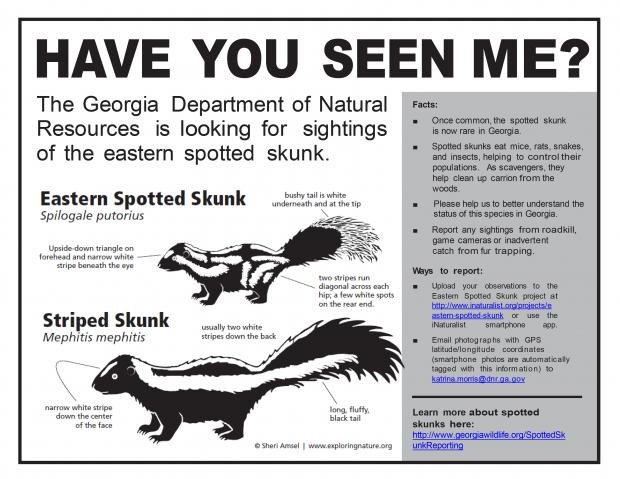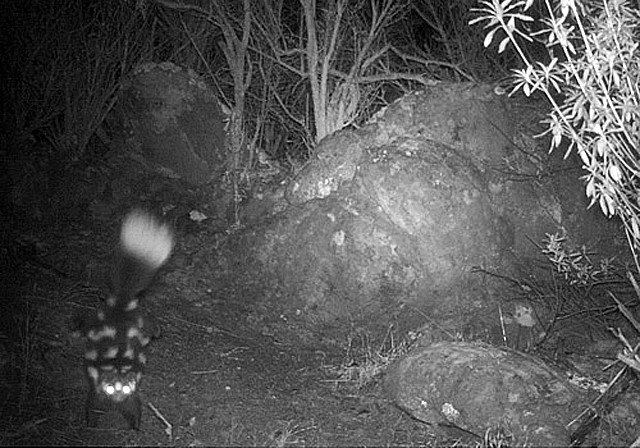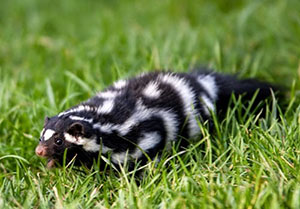 By Emma Alligood and Dr. JT Pynne
By Emma Alligood and Dr. JT Pynne
The eastern spotted skunk, Spilogale putorious, is a once prevalent species throughout the eastern US and Midwest. Now, the species population is down more than 90% due to habitat loss, fragmentation, and land use change. Sightings are rare and difficult to record since the species is nocturnal. Many southeastern states are looking to find out more about these unique skunks from research as well as findings from citizen science and local organizations.
Eastern spotted skunks are part of the Mustelidae family which includes ferrets, otters, and other weasels. These skunks share many physical characteristics with other skunks and mustelids by having long bodies, short legs, and a long, bushy tail. The spots and smaller stripes give them their name. That, plus their much smaller body size, is what sets them apart from the more common striped skunk. Eastern spotted skunks usually have a small spot on their forehead and one above each ear, but patterns can vary widely from completely black (melanistic) to almost completely white (leucistic). Like other mustelids, spotted skunks are found in woody areas, rocky areas, and tall-grass prairies. Spotted skunks are climbers, so their homes can be found above ground instead of only underground in burrows. They are mesocarnivores, meaning they include fruits and other plant parts in their diet. Skunks and other mustelids are known for having well-developed anal scent glands that are used when they feel threatened. Spotted skunks use their anal glands in a unique way to ward off predators – they get into a handstand on their front two legs, turn their heads, and walk towards the predator while spraying them.
 This species started to show signs of population decline almost 80 years ago, but the situation was not brought to light until the early 2000s. Researchers still do not know how most of the population has disappeared. The leading theory is habitat loss. At the start of the population decline, there was suburbanization going on throughout the country which removed many of the forests and prairies that skunks lived in. Recently, there have been two new Eastern spotted skunk subspecies discovered. This could have been due to fragmentation that occurred from habitat loss and suburbanization. During this time, there were also many changes in agricultural practices which led to the use of fertilization and unregulated overharvest. When fertilizers are used, chemicals seep into the ground and potentially into the groundwater, contaminating the area and potentially making the skunks sick.
This species started to show signs of population decline almost 80 years ago, but the situation was not brought to light until the early 2000s. Researchers still do not know how most of the population has disappeared. The leading theory is habitat loss. At the start of the population decline, there was suburbanization going on throughout the country which removed many of the forests and prairies that skunks lived in. Recently, there have been two new Eastern spotted skunk subspecies discovered. This could have been due to fragmentation that occurred from habitat loss and suburbanization. During this time, there were also many changes in agricultural practices which led to the use of fertilization and unregulated overharvest. When fertilizers are used, chemicals seep into the ground and potentially into the groundwater, contaminating the area and potentially making the skunks sick.
 With many states reporting population decline, the Eastern Spotted Skunk Cooperative Study Group was created in 2015. The group came together and created a plan of action to enhance communication between researchers and citizens and create better management practices and research priorities for the species. This study group has encouraged citizens to report sightings from roadkill to footage on game cameras. The increase in game camera use has allowed distributional patterns to be recognized in some areas. Since the study group has been created and the use of technology has increased, there has been a 600% annual increase in publications about the eastern spotted skunk. Getting the word out about a threatened species is one of the best ways to protect it.
With many states reporting population decline, the Eastern Spotted Skunk Cooperative Study Group was created in 2015. The group came together and created a plan of action to enhance communication between researchers and citizens and create better management practices and research priorities for the species. This study group has encouraged citizens to report sightings from roadkill to footage on game cameras. The increase in game camera use has allowed distributional patterns to be recognized in some areas. Since the study group has been created and the use of technology has increased, there has been a 600% annual increase in publications about the eastern spotted skunk. Getting the word out about a threatened species is one of the best ways to protect it.
The Eastern Spotted Skunk Cooperative Study Group is a great place to report sightings, with information on each state’s status and contact information to report sightings. For Georgians, the Department of Natural Resources promotes reporting on the iNaturalist page as well as reporting sightings to the department directly.
References
Bullock, L. 2008. Eastern spotted skunk (Spilogale putorious), Mammals of Mississippi, 12:1-6.
Kobilinsky, D. 2022. Eastern Spotted Skunk Cooperative Study Group Recognized, The Wildlife Society. Retrieved from https://wildlife.org/eastern-spotted-skunk-cooperative-study-group-recognized.
Lariviere, S. 2020. Mustelid. Encylopedia Britannica. Retrieved from https://www.britannica.com/animal/mustelid
Olfenbuttel, C. 2018. Eastern Spotted Skunk- North Carolina Wildlife Profiles, North Carolina Wildlife Resources Commission, Retrieved from https://www.ncwildlife.org/Portals/0/Learning/documents/Profiles/Mammals/Spotted_Skunk_Wildlife%20Profile_2018_FINAL.pdf.
Pennington, S. 2002. Spilogale putorious, Animal Diversity Web, Retrieved from https://animaldiversity.org/accounts/Spilogale_putorius/.

Recent Comments